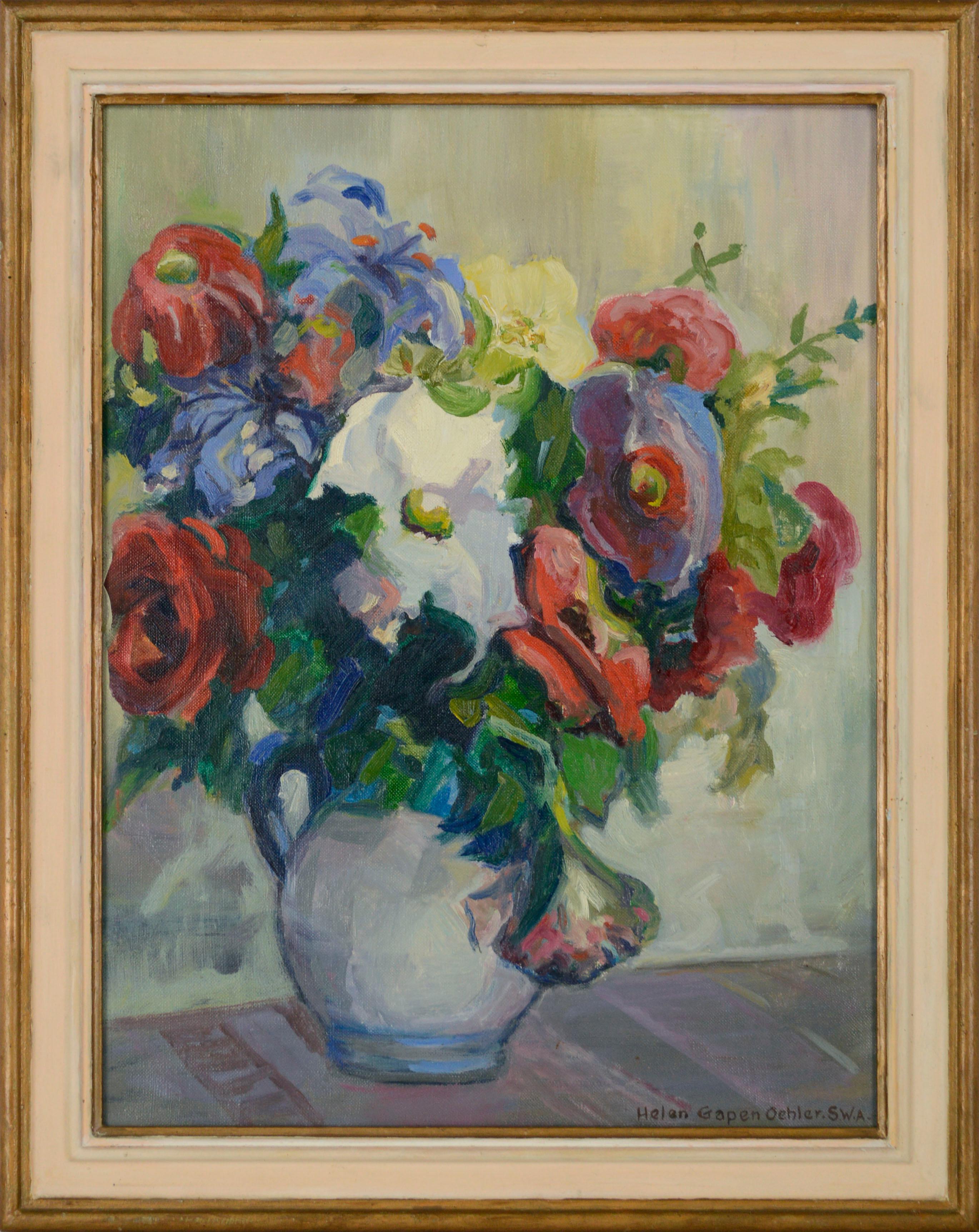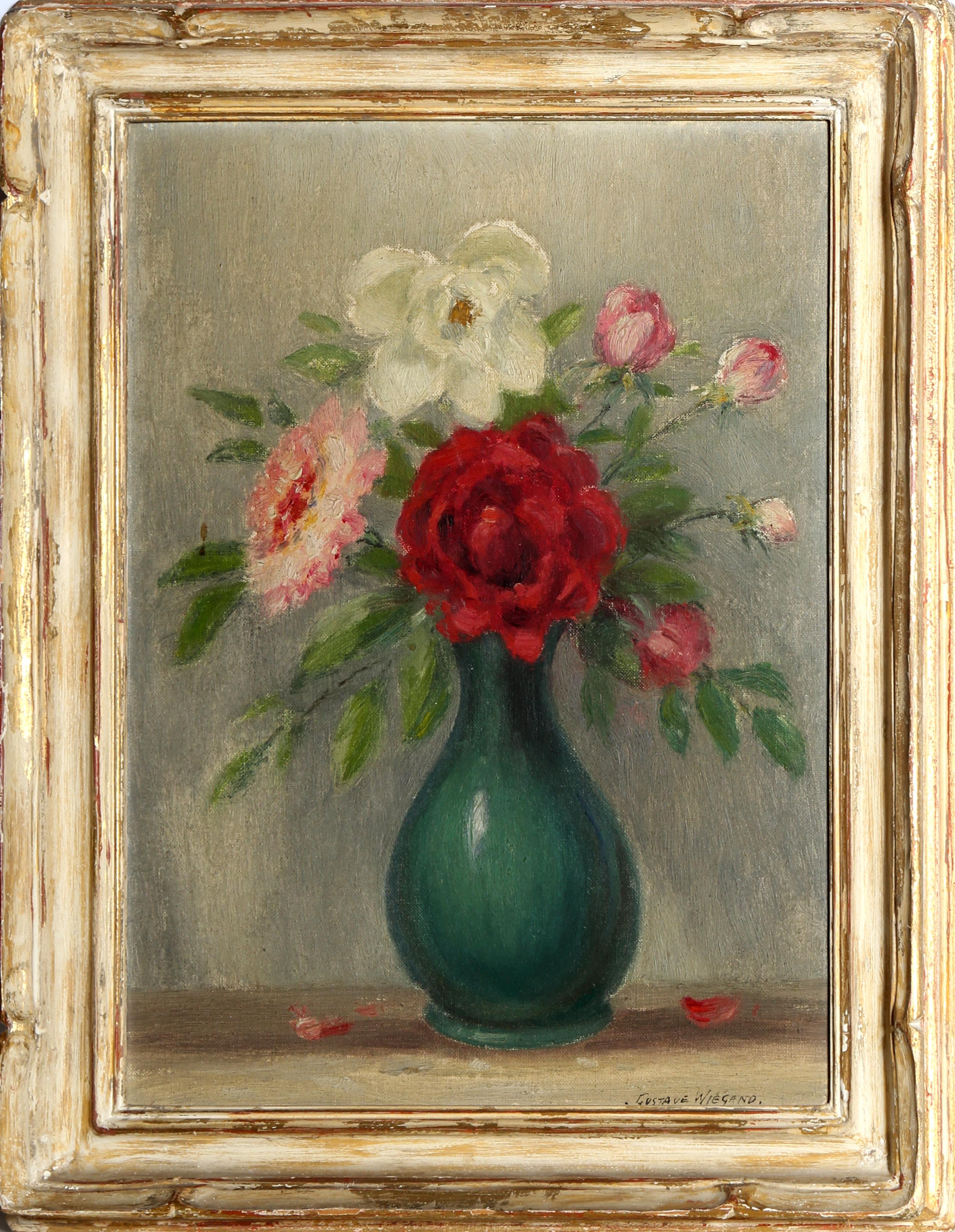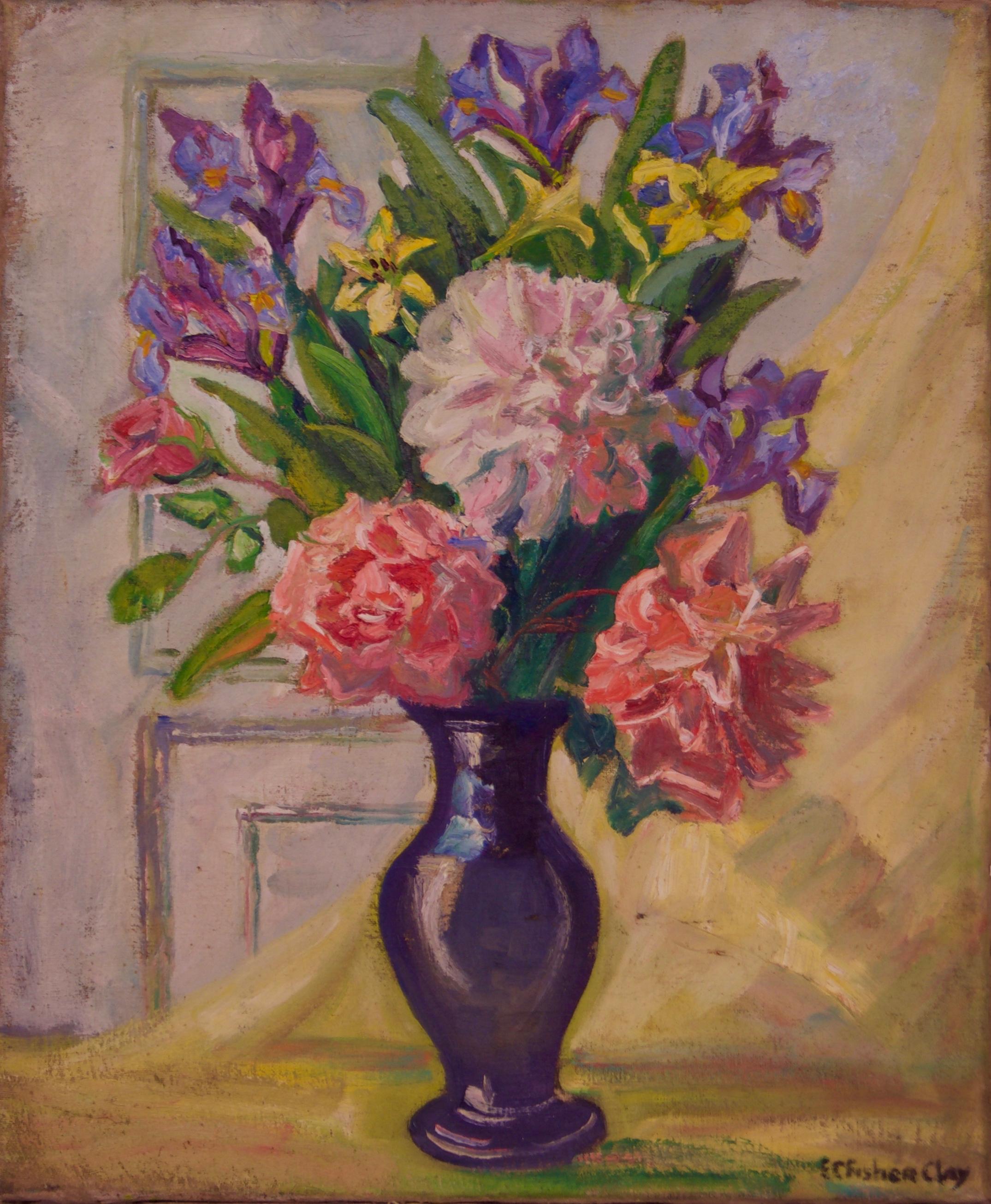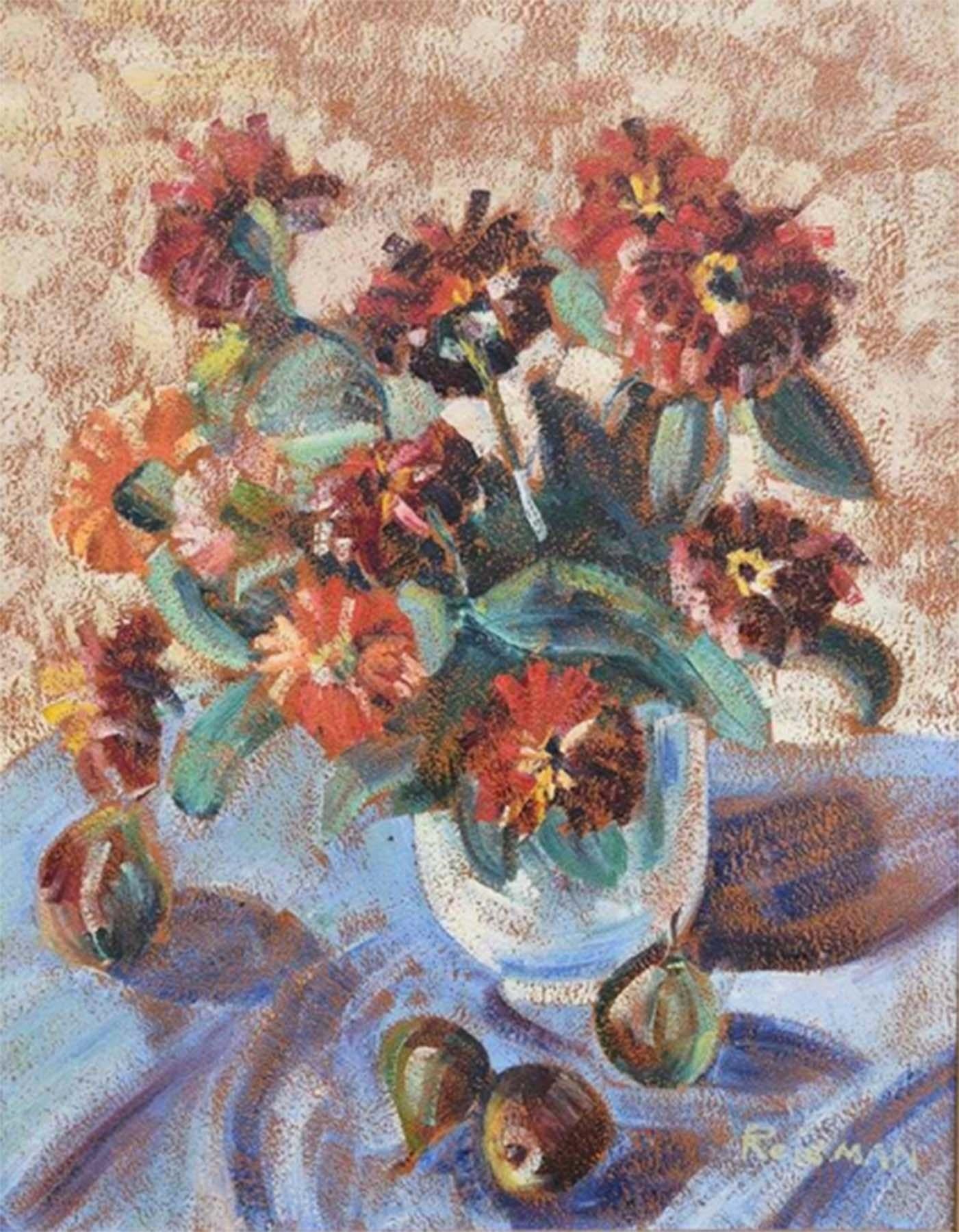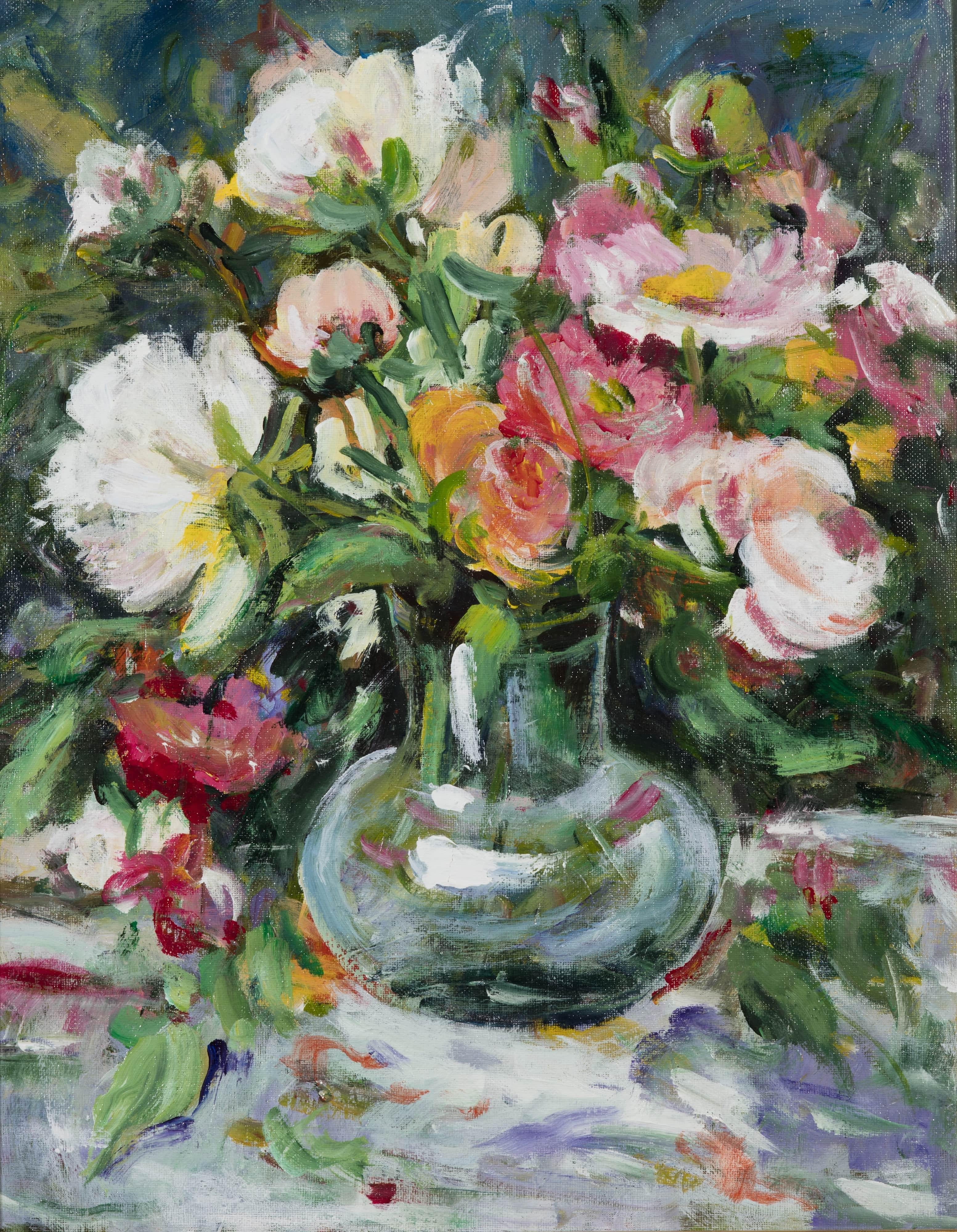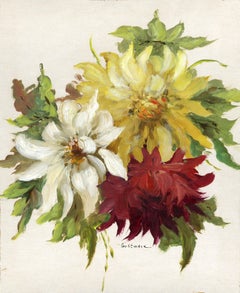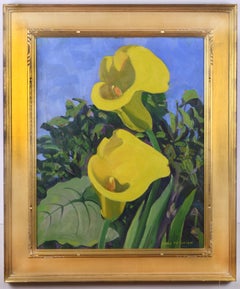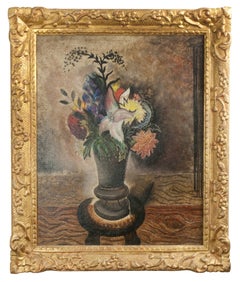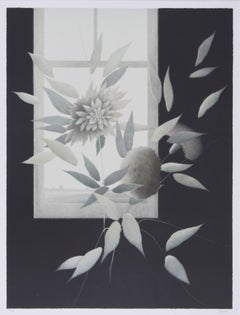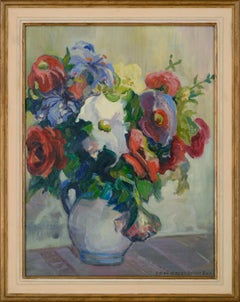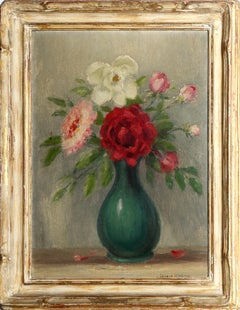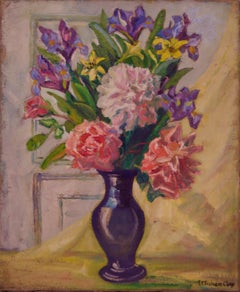Items Similar to Full Bloom
Want more images or videos?
Request additional images or videos from the seller
1 of 8
Robert HallowellFull Bloomc. 1930
c. 1930
$3,500
£2,641.35
€3,023.95
CA$4,936.16
A$5,419.29
CHF 2,827.25
MX$65,580.94
NOK 35,435.25
SEK 33,389.32
DKK 22,572.99
About the Item
Full Bloom
Oil on canvass, 28 x 21 1/2 inches
Signed lower right: Robert Hallowell
Provenance: Estate of the artist
Marbella Gallery, New York
Illustrated in Marbella Gallery catalog: Robert Hallowwell: An Artist Rediscovered, n.d., No. 43, page 13
Exhibited: Robert Halloway, The Mirbella Gallery, Inc.
“There is in Mr. Hallowell’s work a grace that amounts to graciousness.”
Leo Stein (1872-1949)
Robert Hallowell (1886-1939) was highly regarded as an artist exhibiting at the finest galleries and museums in American and France in the 1920’s and 1930’s. His other professional life included graduating from Phillips Academy, Andover and Harvard University. While at Harvard he was president of the Harvard Lampoon (1909-1910) and was a founding member of the now famous New Republic Magazine with Walter Lippman and Herbert Croly. Robert worked there as business manager and publisher from 1914 to 1925, when he left to concentrate on his artistic creativity. Hallowell was an official for the Treasury Department during World War One. His final Government posting was as Assistant Director of the Federal Arts Project in 1935-36. How can someone of such cultural involvement have fallen to total obscurity today?
All the works came from Mildred Thaler Cohen (1921-2012), a noted New York collector and gallerist. Along with her first husband, they started collecting American paintings in the 1950’s when they were out of public favor. Upon the death of her husband, she opened the Marbella Gallery on 72nd Street in Manhattan establishing the reputation of being a connoisseur/dealer. The offerings were displayed in her gallery and home salon style.. When and how the Thaler’s acquired the works remain a mystery.
On my first viewing of Hallowell’s artwork, I was taken with his application of paint (oil and especially watercolor) and his color harmonies and delicate shading. The limited scholarship on the artist tells us he was self-taught. All the more impressive. Today, they stand the test of time and should be regarded for their beauty and for the historic acclaim they achieved in the 1920’s and 30’s.
Public Collections:
Phillips Collection, Washington, D.C.
Cleveland Museum of Art
Brooklyn Museum of Art
Baltimore Museum of Art
Harvard University, Adams Hall
McBride Collection
Lewishon Collection
Arthur B. Davies Collection
Metropolitan Museum of Art
Worcester Art Museum
Museum of the City of New York
Fogg Art Museum, Harvard
Museum of Fine Arts, Boston
Denver Museum
Newark Museum
Wilmington Museum
Selected Exhibitions
Bernheim-Jeune, Paris, 1924, 1925
Montrose Gallery, New York, 1924, 1927, 1929, 1932
Memorial Art Gallery, Rochester, NY 1925
Druet Gallery, Paris 1927
Feragil Gallery, New York 1930
Knoedler Gallery, Chicago 1930
McClaus Gallery, Philadelphia 1933
Macbeth Gallery, New York 1934
Paul Reinhardt Gallery, New York 1939
Babcock Gallery, New York 1949
Baltimore Museum of Art
Corcoran Gallery, Washington D.C.
Art Institute of Chicago 1925, 1926, 1927
Pennsylvania Academy of Fine Arts 1927, 1928, 1929
Brooklyn Museum, American Watercolors, Pastels, Collages, 1984
Excerpts from reviews of Hallowell’s exhibitions:
Royal Cortissoz (Art Critic New York Herald Tribune), 1924
“He is a firm and spirited workman, clever in the notation of his light, and very good in his color.”
Leo Stein (1872-1949) noted art critic and brother of Gertrude Stein, wrote in 1925
“There is in Mr. Hallowell’s work a grace that amounts to graciousness.”
New York Times Obituary Notice, Jan. 28, 1939
“…in 1926 a large showing of his watercolors and oils in the Montrose Gallery in New York established his American reputation.”
Elizabeth Luther Cary (1967-1936, the first art critic at the New York Times), 1935
“The paintings of Robert Hallowell speak in fewer words of greater things…Done expertly with a personal emotion…”
Ronald G. Pisano (1948-2000), noted American Art Historian and scholar on the works of William Merritt Chase wrote in the Marbella Gallery catalog of Robert Hallowell’s works:
“His art, like many of his contemporaries, reveals his interest in modernist tendencies introduced to American art in the early 20th century. It is only within recent years that artists such as Hallowell are being appreciated for their full value and whose historical significance is now emerging.”
- Creator:Robert Hallowell (1886-1939, American)
- Creation Year:c. 1930
- Dimensions:Height: 28 in (71.12 cm)Width: 21.5 in (54.61 cm)
- Medium:
- Movement & Style:
- Period:
- Condition:Recently cleaned by my conservator Unframed.
- Gallery Location:Fairlawn, OH
- Reference Number:Seller: FA95701stDibs: LU14014345922
About the Seller
5.0
Recognized Seller
These prestigious sellers are industry leaders and represent the highest echelon for item quality and design.
Platinum Seller
Premium sellers with a 4.7+ rating and 24-hour response times
Established in 1978
1stDibs seller since 2013
814 sales on 1stDibs
Typical response time: <1 hour
Associations
International Fine Print Dealers Association
- ShippingRetrieving quote...Shipping from: Fairlawn, OH
- Return Policy
Authenticity Guarantee
In the unlikely event there’s an issue with an item’s authenticity, contact us within 1 year for a full refund. DetailsMoney-Back Guarantee
If your item is not as described, is damaged in transit, or does not arrive, contact us within 7 days for a full refund. Details24-Hour Cancellation
You have a 24-hour grace period in which to reconsider your purchase, with no questions asked.Vetted Professional Sellers
Our world-class sellers must adhere to strict standards for service and quality, maintaining the integrity of our listings.Price-Match Guarantee
If you find that a seller listed the same item for a lower price elsewhere, we’ll match it.Trusted Global Delivery
Our best-in-class carrier network provides specialized shipping options worldwide, including custom delivery.More From This Seller
View Alluntitled (Peonies)
By Frederick Carl Gottwald
Located in Fairlawn, OH
Untitled (Peonies)
Oil on artist's board, c. 1910-1920's
Signed by the artist in ink lower center (see photo)
Provenance:
Joseph Erdelac, Private Collector, Cleveland, acquired from ...
Category
Early 20th Century American Impressionist Still-life Paintings
Materials
Oil
Lilies
By Jane Peterson
Located in Fairlawn, OH
Jane Peterson (1876-1965)
Lilies
Oil on canvas, 1952-1953
Signed by the artist lower right: JANE PETERSON
(see photo)
Painting size: 29 x 23 inches
Frame size: 38 x 32-1/2...
Category
1950s American Impressionist Still-life Paintings
Materials
Oil
$24,000
Still Life with Vase of Flowers
By Konrad Cramer
Located in Fairlawn, OH
Still Life with Vase of Flowers
Oil on board with incised scraffito, c. 1929-1930
Unsigned by the artist
Signed and inscribed verso: "Painting by my father, Aileen B. Cramer" verso, ...
Category
1920s American Modern Paintings
Materials
Oil
Studio Flowers
By Robert Kipniss
Located in Fairlawn, OH
Studio Flowers
Lithograph, 1982
Signed lower right (see photo)
Numbered lower left
Edition: 120 (42/120) (see photo)
Condition: Mint condition
Two bits of hinge residue verso
Image s...
Category
1980s American Realist Still-life Prints
Materials
Lithograph
Iris
By Greta Allen
Located in Fairlawn, OH
Iris
Watercolor on paper, c. 1920
Unsigned
Provenance: Estate of the Artist
Condition: Excellent, slight surface dirt
Image/Sheet size: 15 x 10 1/4 inches
Allen was trained in Boston...
Category
20th Century American Impressionist Still-life Drawings and Watercolors
Materials
Watercolor
Buds
By Jack Beal
Located in Fairlawn, OH
Buds
Color lithograph, 1980
Signed, titled, and editioned in pencil by the artist
Publisher: Art Matters
Printer: Bud Shark, Shark's Ink, Lyons, CO
Condition: Excellent
Image: 31-1/8 x 41-1/4" (79 x 104.7 cm.)
"An Abstract Expressionist when he left the Art Institute of Chicago in 1956, Beal has since become a dedicated realist who sees art as a potentially powerful moral force. He has great regard for Platonic ideals of truth, beauty, and goodness, and admires both the realism of seventeenth-century Dutch painting and the compositional authority of Renaissance art. Since moving to New York in the late 1950s with his wife, painter Sondra Freckelton, Beal has painted still lifes, portraits, and landscapes, although in recent years his most ambitious undertakings have been large-scale allegories and myths. In describing his approach, Beal calls himself a "life painter" and says he is committed to human over aesthetic concerns. Yet his intricate complexes of figures and surface patterns, along with his adroit handling of space, reveal his sophisticated, accomplished sense of composition.
Virginia M. Mecklenburg
Biography
Jack Beal (1931-2013) was born and raised in Richmond, Virginia. He briefly attended the College of William and Mary, studying biology, but dropped out after two years. A decision to take evening art classes lead to his attending the Art Institute of Chicago, where he studied from the old masters in the Institute’s collection and with Isobel Steele MacKinnon, a student of Hans Hoffman. His classmates there included Red Grooms, Richard Estes, Claes Oldenberg and Robert Barnes, and while abstract expressionism remained “the only valid way to paint,” it was a style that all would eventually reject. In 1956 Beal left the Art Institute and moved to New York with the aim of finding success as a painter, eventually becoming one of the first artists to settle in the SoHo neighborhood.
A turning point came in 1962 when, spending the summer in upstate New York, Beal decided to begin painting outdoors. Dissatisfied with abstract painting, he “wanted to give Art one more try” and in working from nature “fell in love with painting all over again.” Over the next few years Beal worked toward a balance between expressionistic paint handling and realistic, narrative pictures. Clement Greenberg’s pronouncement around this time, that the figure was no longer a valid subject was taken as a challenge by many artists, Beal included. His subsequent adoption of the female nude - modeled by his wife, the artist Sondra Freckelton - was a break-through. Though the paintings retained the sensuousness of his earlier canvases, the rigorous formality of their composition and the masterful treatment of light and shadow offered a new approach to realist painting. Indeed, Beal was not alone in this transformation; friends and colleagues in New York were coming to similar conclusions and the group, who included painters such as Philip Pearlstein, Alfred Leslie, Yvonne Jacquette, Alex Katz, Jack Tworkov, Nell Blaine and Fairfield Porter, would eventually be considered the ‘New Realists.’
With the resurgence of figurative painting, Beal distinguished himself for his skillful handling of color and modeling as well as what was later described as his “pushing of representational forms to their interface with abstraction”. Through the later half of the 1960s, while his subject matter remained unchanged, his paintings were increasingly given over to wide areas of flat color. In 1969, he exhibited a series of Table Paintings which, with their hard-edge style and near complete abstraction of the form, were a radical departure for Beal. So radical in fact, he was accosted by fellow realist painters Alfred Leslie and Sidney Tillim, who berated him “for betraying realism and betraying [himself], for moving away from ‘the true path’.” The incident had its intended effect and Beal did return to a more naturalistic and humanistic style, eventually abandoning the nude in favor of increasingly allegorical portraits. In 1974, the United States General Services Administration commissioned Beal to produce a series of murals for the U.S. Department of Labor headquarters in Washington D.C. The result was The History of Labor, four, 12 x 13 foot paintings in the vein of George Caleb Bingham, each illustrating a century of American development.
Following the completion of the murals in 1977, Beal continued to make use of narrative in his paintings, with portraiture and self-portraiture as a means of exploring moral and didactic themes. He and Sondra had purchased an old mill in upstate New York in 1974 and after extensive renovations, it became their permanent residence. Unsurprisingly, many of his later paintings are pastoral scenes based on his rural surroundings or still lives including flowers which they grew on the property. In 1986, Beal was commissioned by the Art in Transit Initiative to create a large-scale mural as part of the redevelopment of the Times Square Subway Station. The proposed mosaic mural, The Return of Spring, took over fifteen years to complete, with the two, 7 x 20 foot sections finally installed in 2001 and 2005. Together they update the Greek myth of Persephone with a New York setting, showing her abduction by Hades, initiating the arrival of winter, and her release, bringing the bountiful return of spring.
Beal was a founder of the Artist’s Choice Museum, New York and the New York Academy of Art as well as the recipient of numerous grants and awards, including honorary degrees from the Art Institute of Boston and the Hollins College...
Category
1980s Contemporary Still-life Prints
Materials
Lithograph
$1,200
You May Also Like
Spring Bouquet, Mid Century Floral Still-Life
By Helen Gapen Oehler
Located in Soquel, CA
A lush spring bouquet bursts forth with a bounty of beautiful, vibrant flowers in bloom in this mid century floral still-life by Helen Gapen Oehler (American, 1893-1979). Signed "Helen Gapen Oehler S.W.A" (Society of Western Artists) lower right. Displayed in a wood frame painted light peach with gold trim. Canvas size: 18"H x 14"W.
Best known for her landscapes, seascapes, views of nature as well as paintings of scenes from global travel, Oehler is considered a progressive impressionist. She painted in the world, Midwest and eastern coast, some California.
Helen Gapen Oehler was born in 1893 in Ottawa Illinois. She was bright and at an early began to paint. Helen Oehler attended and graduated from the University of Illinois in art and teaching and was in the Chi Omega sorority...
Category
Mid-20th Century American Impressionist Still-life Paintings
Materials
Linen, Oil
$1,080 Sale Price
20% Off
Flower Still Life, Impressionist Oil Painting by Gustave Weigand
By Gustave Weigand
Located in Long Island City, NY
An oil on board painting by Gustave Weigand (1870 - 1957), signed lower right. Painting measures 16 x 12 inches. Wiegand was born in Bremen, Germany in 1870. Wiegand studied at the R...
Category
1940s American Impressionist Still-life Paintings
Materials
Oil
Still Life Flowers - Early 20th Century Oil on Canvas by E C Fisher Clay
Located in Watford, Hertfordshire
Elizabeth Campbell Fisher Clay (1871-1959) was an American artist and printmaker who studied art in Boston, New York, and Paris. After h...
Category
Early 20th Century Post-Impressionist Still-life Paintings
Materials
Canvas, Oil
STILL LIFE WITH FROWERS
By Philip Reisman
Located in Los Angeles, CA
PHILIP REISMAN
"STILL LIFE WITH FROWERS"
OIL ON PANEL. SIGNED
AMERICAN, C.1935
20 X 16 INCHES
Philip Reisman
1904-1992
Philip Reisman was born July 18, 1904 in Warsaw, Poland....
Category
1930s Impressionist Still-life Paintings
Materials
Oil, Panel
Floral Still life I
Located in Boston, MA
Artist Commentary:
This floral was panted in my studio during the very cold winter months.
Keywords: Abstract, Bold, Pop & Graphic, Expressive & Gestural, stripes, green, blue, pink...
Category
21st Century and Contemporary Impressionist Still-life Paintings
Materials
Canvas, Acrylic
"Summer Flowers"
By Joseph Barrett
Located in Lambertville, NJ
Illustrated in "Joseph Barrett, The Prime Years 1970s - 1990s", pg. 10 #010
Jim’s of Lambertville is proud to offer this artwork by:
Joseph Barrett (1936 – )
Joseph Barrett was born in Midland, North Carolina, in 1936 and studied at the Massachusetts College of Art in Boston and at the Tyler School of Art in Philadelphia. Barrett, now of Lahaska, Pennsylvania, has been painting his entire adult life. His favorite subjects include the landscape surrounding New Hope and many local landmarks often encompassing figures into his compositions. Barrett utilizes a heavy impasto and his palette bears similarities to that of Fern Coppedge and George Sotter. Barrett’s paintings are always found in unique and somewhat charming handmade frames designed by the artist and finished in metal leaf.
A living contemporary of the no longer living “New Hope School” impressionist painters, Joseph Barrett resides outside of New Hope above his old-fashioned antique shop and studio. Entering Barrett’s shop is like taking a step back in time. Inside this cluttered and dusty haven of treasures from the past, is a studio spanning only four by eight feet. This little studio, containing cans of old brushes and hundreds of used paint tubes...
Category
Late 20th Century American Impressionist Still-life Paintings
Materials
Canvas, Oil
More Ways To Browse
Fruit Basket Painting
Oil Painting Nest
Bread Still Life
Denver Modern
Hyper Realistic Art
Oil On Porcelain
Paris Flower Painting
Ashot Muradyan
Blue Bottles Painting
Blue Irises Painting
Peony Flower Painting
Fruit Tables Oil Painting
Grand Central Atelier
Original Painting Lemon
Petit Fours
Pineapple Painting
Wine Glass Painting
Art Ledge
